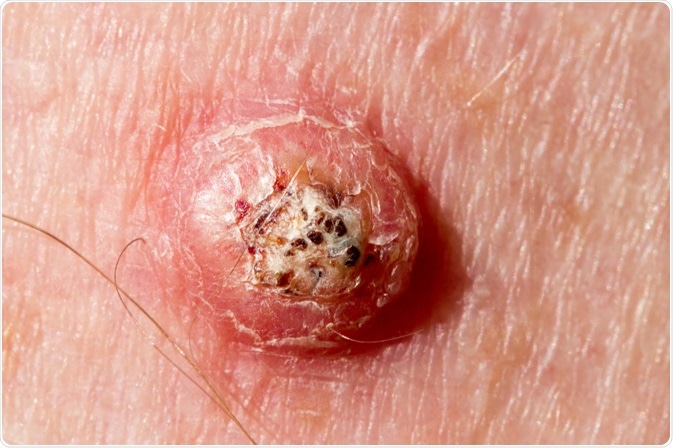A keratoacanthoma is a relatively common growth on the skin. It is a fast-growing, small-sized, benign skin tumor that originates in the hair follicles. It is usually not associated with any internal malignancy unless there are multiple skin lesions.
One variant with multiple keratoacanthomas is actually Muir-Torre syndrome, a genetic illness. The condition is also referred to as well-differentiated Squamous Cell Carcinoma, Keratoacanthoma or SCC, KA type.
There is no known reason for the formation of keratocanthomas, but some people have been found to be at higher risk of developing this kind of benign epithelial neoplasm. It tends to form on sun-damaged skin, especially in the elderly. There is no certain way of knowing who is likely to develop these abnormal growths on the skin, as individuals only in their thirties have also reported the condition.
The affected part of the skin may experience some discomfort and irritation. Resolution may be through surgical removal of the lesion or as a result of its eventual spontaneous recession after a time. Permanent scars are left behind. These scars may require cosmetic surgery to restore the skin to a relatively normal look.

Image Credit: Peter Mullineux / Shutterstock
Who is at Risk of Developing Kkeratoacanthoma?
While there is no explicit cause for the development of these skin nodules, it is believed that prolonged exposure to harmful ultraviolet rays of the sun tend to trigger the condition. The damage caused by these rays to the skin DNA results in the formation of a keratoacanthoma. Therefore, those who are prone to spending long periods out in the sun are at a greater risk of developing this lesion.
This epithelial neoplasm is likely to appear on sun-exposed areas of the skin, such as on the face, hands, neck and legs. The condition is found in both men and women, although the percentage of men affected is slightly higher in many studies. This may be because men are more likely to have jobs that are outdoors, leading to higher exposure to the UV rays.
The age group most likely to develop this skin condition is between 60 to 70 years. Although there have been cases of younger people developing the Keratoacanthomas as well. Light skinned people are more likely to get Keratoacanthoma than dark skinned people. This is why Caucasians tend to be more prone to Keratoacanthoma than Hispanics or Asians.
Predisposing Factors
There are a number of risk factors for the development of a keratoacanthoma. The presence of any of these risk factors does not mean that the individual will develop this abnormal skin growth. However, it does increase the chances as compared to an individual who has few or no risk factors. Here we look at a few of them.
- Exposure to ultraviolet radiation. This is caused by spending long periods of time in the sun due work requirements or participating in many outdoor activities.
- Frequent use of artificial tanning processes. The excessive use of tanning beds causes skin damage, leaving it prone to developing keratoacanthoma.
- Muir-Torre syndrome. This is a genetic disorder in which multiple skin lesions of Keratoacanthoma grow in clusters on the patient’s skin. Those with a family history of the disease are at risk.
- Weakened immune systems caused by treatment of cancer, AIDS or the use of immunosuppressant drugs can also trigger the growth of a keratoacanthoma.
- A keratoacanthoma may also be found on a previous burn site. It is hypothesized that this is because skin burns also damage the DNA of the affected area.
- Those undergoing radiation therapy or who are exposed to arsenic and coal tar are also at a higher risk of developing this tumor.
- People who are addicted to chewing tobacco or smoking have a higher risk for this condition. Both activities are damaging to the immune system.
- Essentially anyone who has sensitive skin which can get sunburnt easily is in a higher risk group. This means that light-skinned individuals are more likely to develop keratoacanthoma than those with darker skin tones.
Other Facts About Keratoacanthoma
A single keratoacanthoma is a low-grade skin tumour with no metastasis. This means that there is no secondary growth from the primary skin tumour. There is just a single lesion which grows to a specific size and then spontaneously recedes after a certain time frame. No second lesion is caused by the presence of the first one.
The diagnosis is done through a tissue biopsy. The skin lesion is scraped off or excised by a dermatologist and sent to a pathologist for microscopic study. Since keratoacanthoma lesions are very similar to squamous cell carcinomas, it is vital to get an early diagnosis. SCC are malignant and can spread to other organs such as the lips, oesophagus, inside the mouth and other parts of the skin.
Further Reading
Last Updated: Feb 24, 2023